The AMD Radeon R9 290X Review
by Ryan Smith on October 24, 2013 12:01 AM EST- Posted in
- GPUs
- AMD
- Radeon
- Hawaii
- Radeon 200
Bioshock Infinite
Bioshock Infinite is Irrational Games’ latest entry in the Bioshock franchise. Though it’s based on Unreal Engine 3 – making it our obligatory UE3 game – Irrational had added a number of effects that make the game rather GPU-intensive on its highest settings. As an added bonus it includes a built-in benchmark composed of several scenes, a rarity for UE3 engine games, so we can easily get a good representation of what Bioshock’s performance is like.
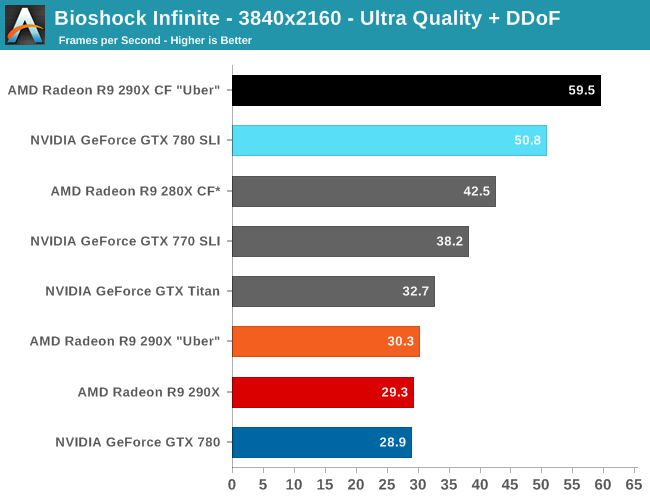

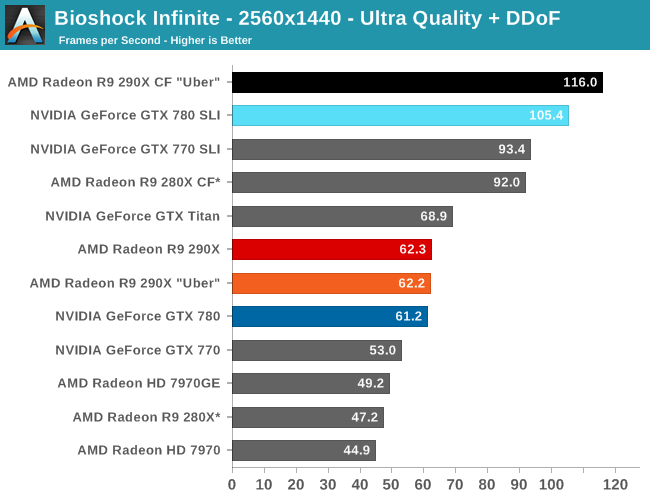
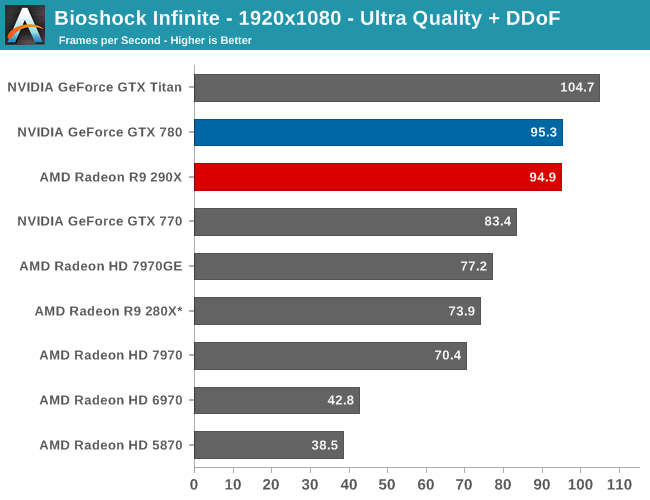
The first of the games AMD allowed us to publish results for, Bioshock is actually a straight up brawl between the 290X and the GTX 780 at 2560. The 290X’s performance advantage here is just 2%, much smaller than the earlier leads it enjoyed and essentially leaving the two cards tied, which also makes this one of the few games that 290X can’t match GTX Titan. At 2560 everything 290X/GTX 780 class or better can beat 60fps despite the heavy computational load of the depth of field effect, so for AMD 290X is the first single-GPU card from them that can pull this off.
Meanwhile at 4K things end up being rather split depending on the resolution we’re looking at. At Ultra quality the 290X and GTX 780 are again tied, but neither is above 30fps. Drop down to Medium quality however and we get framerates above 60fps again, while at the same time the 290X finally pulls away from the GTX 780, beating it by 14% and even edging out GTX Titan. Like so many games we’re looking at today the loss in quality cannot justify the higher resolution, in our opinion, but it presents another scenario where 290X demonstrates superior 4K performance.
For no-compromises 4K gaming we once again turn our gaze towards the 290X CF and GTX 780 SLI, which has AMD doing very well for themselves. While AMD and NVIDIA are nearly tied at the single GPU level – keep in mind we’re in uber mode for CF, so the uber 290X has a slight performance edge in single GPU mode – with multiple GPUs in play AMD sees better scaling from AFR and consequently better overall performance. At 95% the 290X achieves a nearly perfect scaling factor here, while the GTX 780 SLI achieves only 65%. Curiously this is better for AMD and worse for NVIDIA than the scaling factors we see at 2560, which are 86% and 72% respectively.
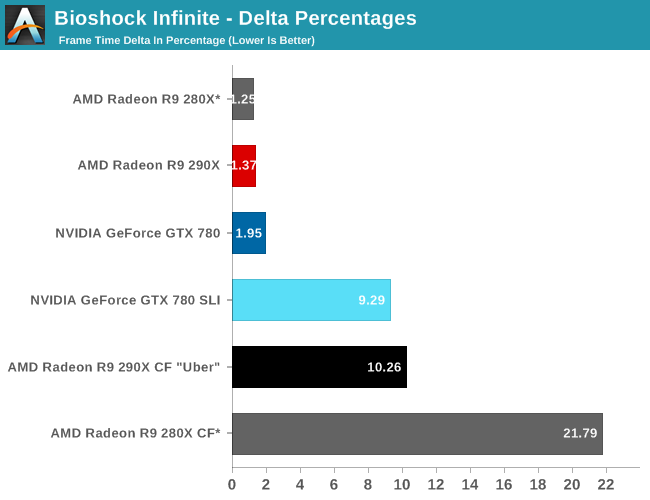

Moving on to our FCAT measurements, it’s interesting to see just how greatly improved the frame pacing is for the 290X versus the 280X, even with the frame pacing fixes in for the 280X. Whereas the 280X has deltas in excess of 21%, the 290X brings those deltas down to 10%, better than halving the variance in this game. Consequently the frame time consistency we’re seeing goes from being acceptable but measurably worse than NVIDIA’s consistency to essentially equal. In fact 10% is outright stunning for a multi-GPU setup, as we rarely achieve frame rates this consistent on those setups.
Finally for 4K gaming our variance increases a bit, but not immensely so. Despite the heavier rendering workload and greater demands on moving these large frames around, the delta percentages keep to 13%.


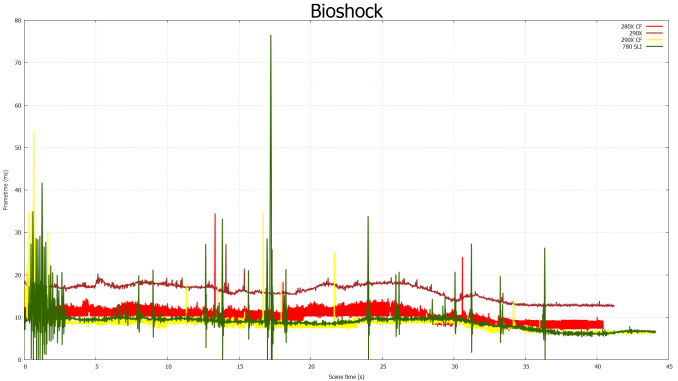









396 Comments
View All Comments
TheJian - Friday, October 25, 2013 - link
Wrong, Zotac price in cart $624. :) Personally I'd buy an OC card for $650 but that's just me.http://www.newegg.com/Product/Product.aspx?Item=N8...
46andtool - Thursday, October 24, 2013 - link
your comment makes no sense, all I see are excuses and misinformation in your post." It doesn't cost less than a GTX780, it only has a lower MSRP." is just stupid, battlefield 4 edition 290xs are already on newegg for $579, the only cheap 780gtxs you will find will be used ones.chrnochime - Thursday, October 24, 2013 - link
What 549? Every 780 on NE goes for 649. I want some of the kool-aid you're drinking.HisDivineOrder - Friday, October 25, 2013 - link
It IS loud. HardOCP have a tendency to be so "hard" they ignore the volume of the card. They aren't the most reliant of sites about the acoustics of a card. Not in the past and not today.JDG1980 - Thursday, October 24, 2013 - link
Regarding 1080p performance, so what? You don't need a $500+ video card to get acceptable frame rates at that resolution. A $200-$300 card will do just fine. $500+ video cards are for multi-monitor setups or high resolution (1440p+) displays.Regarding the noise, that's a problem - AMD clearly stretched things as far as they could go with GCN to reach the current performance level. I know that EK has already announced a 290X waterblock for those enthusiasts who use custom loops. I wouldn't be surprised to see someone come out with a self-contained closed-loop watercooler for the 290X, similar to those that have been available for CPUs for a couple years now. That might help fix the noise issues, especially if it used a dual 120mm/140mm radiator.
46andtool - Thursday, October 24, 2013 - link
we are just now breaking 60fps on 1080p on demanding games at max details, and even more demanding games are just around the corner so your telling people what exactly? And everybody knows AMD makes retarded reference coolers. So another moot point. Lets-try-and -discredit- AMDs- stellar -new product -anyway -we -can- but- the- only- way- we -know -how -is -by -grasping- at- straws.inighthawki - Thursday, October 24, 2013 - link
BS, there's absolutely nothing wrong with a high end card on a 1080p display. Just look at the benchmarks, Crysis 3 1080p on high, a 7970GE barely hits 60fps, and no doubt that will drop below 60 on many occasions (it's just an average). On top of that, not all games are nearly as well optimized as Crytek games, or are just far more complex. Total War: Rome 2, even the 290X doesn't barely hits 60fps on extreme with MEDIUM shadows. Or maybe look at Company of Heroes 2, and how even the 290X hits a min fps of 37fps on extreme.On top of all of that, high resolution IPS panels are super expensive, not everyone cares enough about that to spend the money. The difference between a quality 1080p and a quality 1440p panel can be almost as much as the video card itself.
patrioteagle07 - Thursday, October 24, 2013 - link
Not really... You can find refurbed ZR30s for under $600If you are going to spend 1k on gfx its rather short sighted to keep your TN panels...
inighthawki - Thursday, October 24, 2013 - link
That's at LEAST several hundred dollars more than the majority of people are willing to spend on a monitor. 1080p TN panels are fine for most people, including most gamers. What people care about is not monitor count, pixel count, or color accuracy. They want high quality shaded pixels and good framerate. This is where high end video cards on smaller monitors comes into play. There are plenty of reasons to do it. Do not confuse your own values as the same as what everyone else wants.ShieTar - Friday, October 25, 2013 - link
Also, an increasing number of players is considering 120 FPS to be the acceptable framerate, not 60FPS.